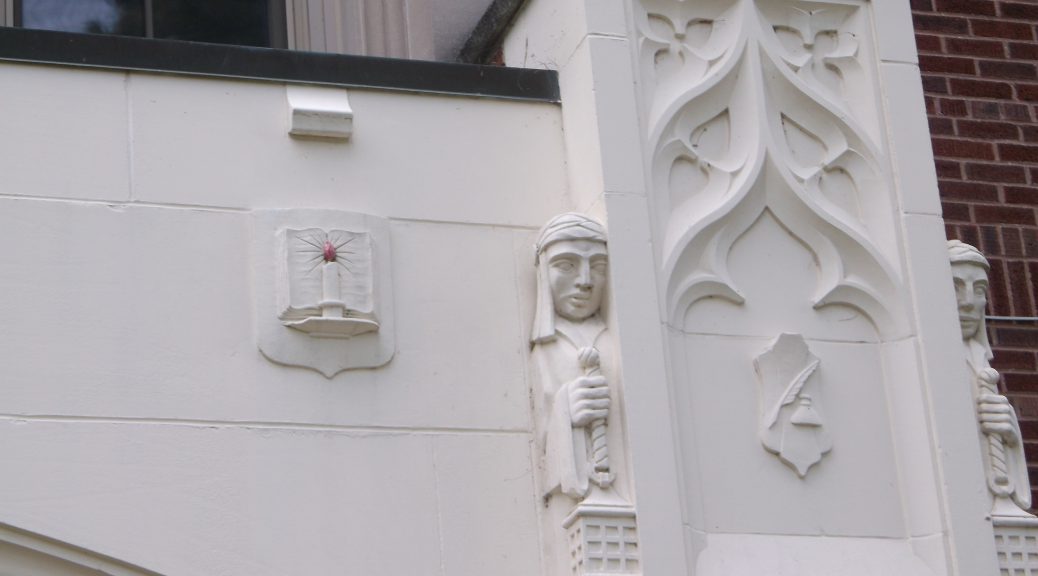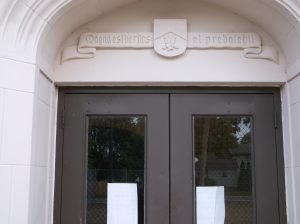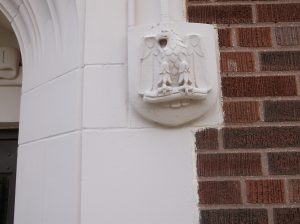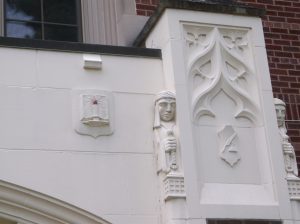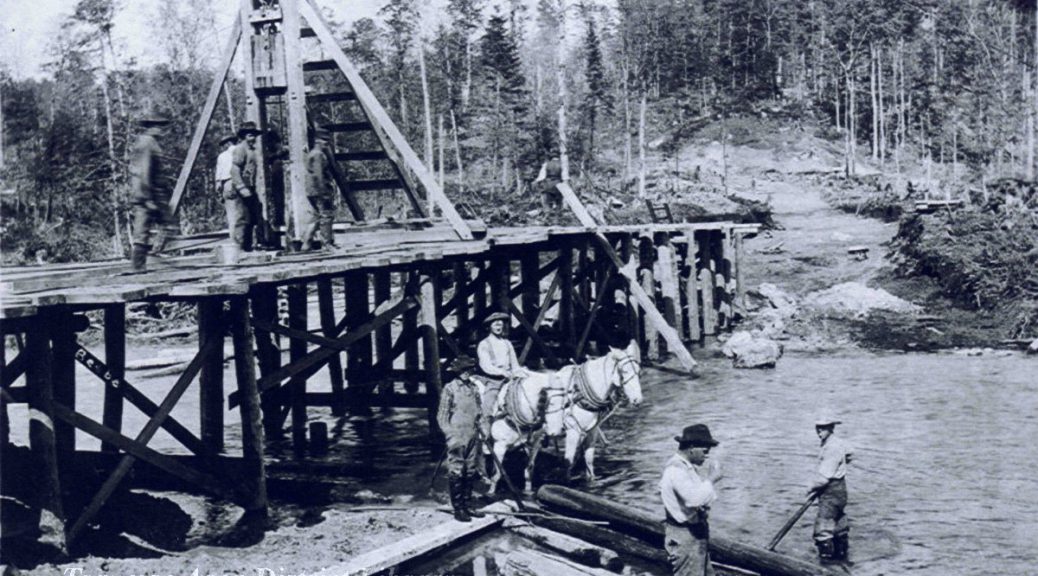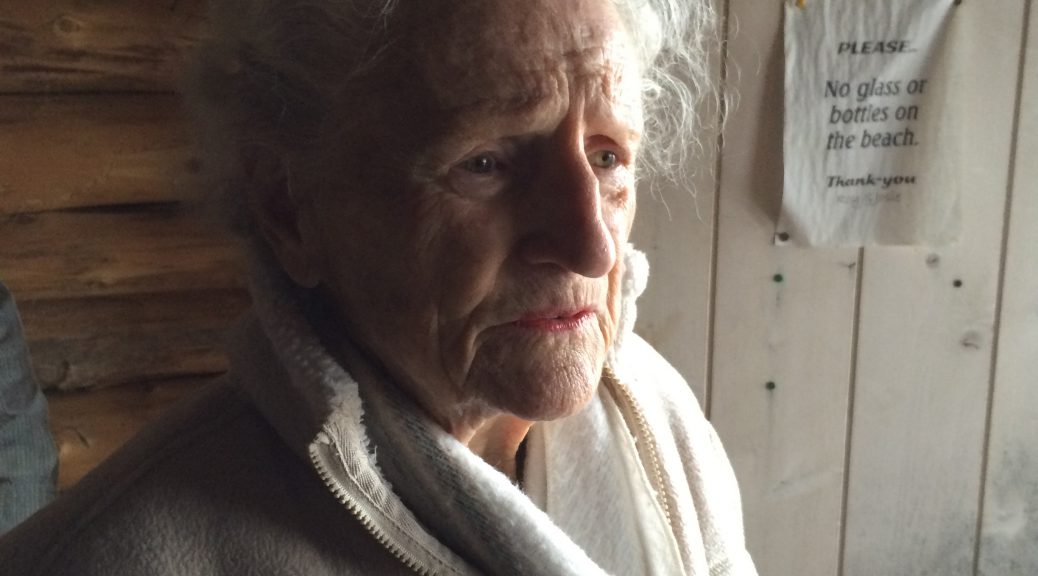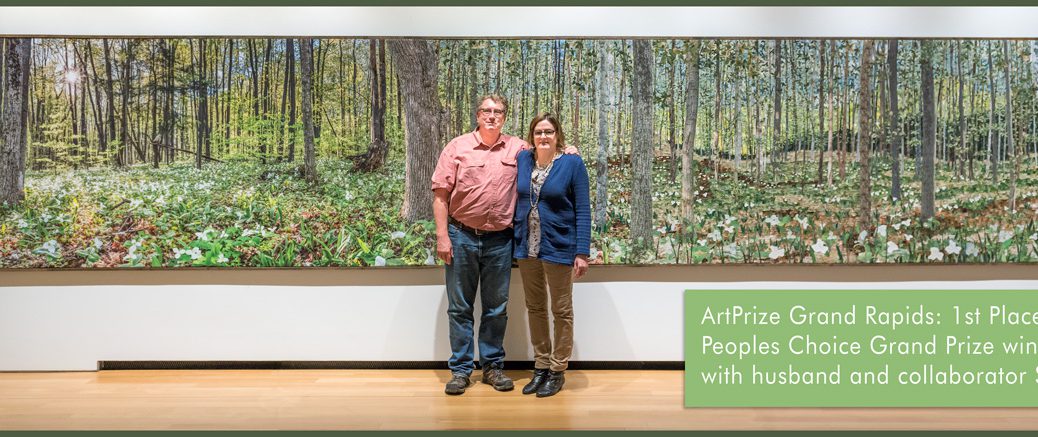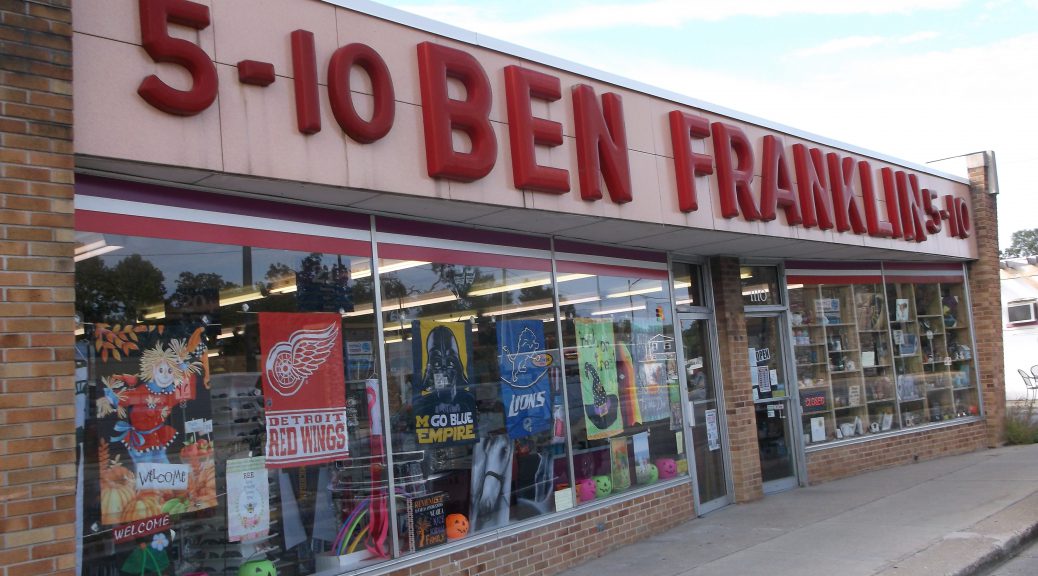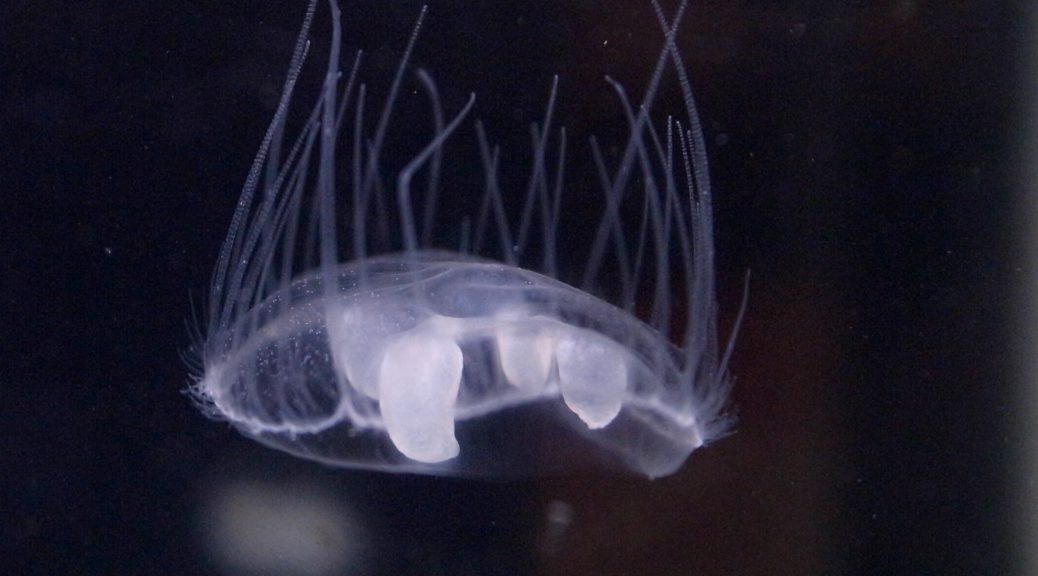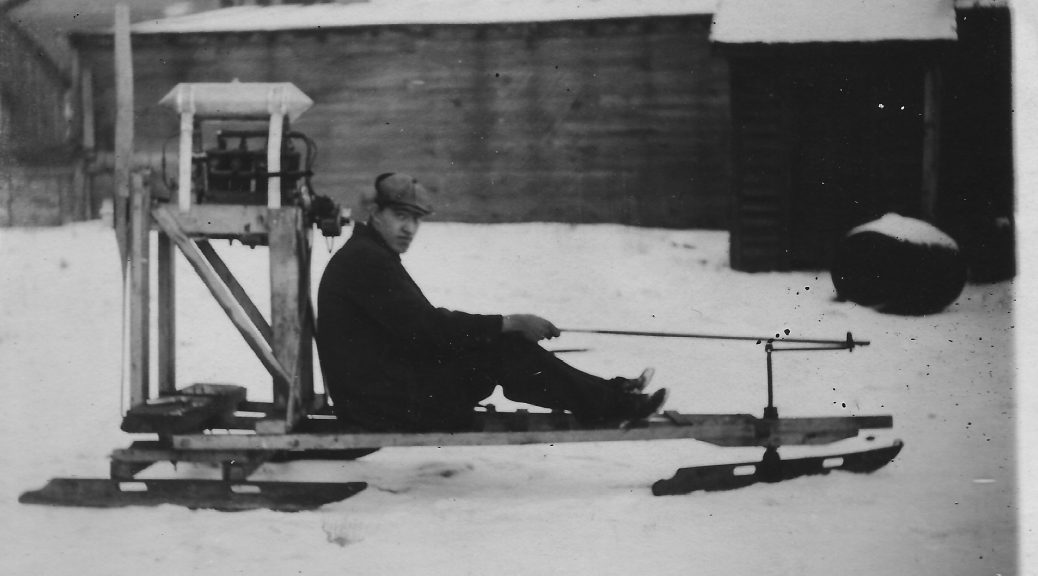The architectural style of this school has sometimes been called “Collegiate Gothic” for its pointed arches and interesting ornaments. One school in the Traverse area illustrates this style better than all others: what is it?
Monthly Archives: October 2016
Readers Flounder in Ruggs Pond
Ruggs Pond is formed by a dam originally intended to generate power for what Northern Michigan community? (Hint: it forms at the junction of two tributaries of Rapid River)
Regrettably, not one person recognized that the dam at Ruggs Pond provided hydroelectric power to Kalkaska, Michigan. We encourage you to visit the Pond. It is a beautiful place.


Betty Beeby: Iconic Artist of “Up North,” 1923-2015
Betty Beeby, interviewed by the Women’s History Project of Northwest Michigan, on May 7, 2003, at her home in Eastport. Learn more about the Women’s History Project at their website, https://whpnm.wordpress.com/
I was born in Detroit, Michigan, in 1923 when they didn’t have images of the baby-to-come. When they told my father that he had twins, he was so overjoyed that he did cartwheels down the entire corridor of Henry Ford Hospital.
We came Up North to Torch Lake every summer. My great-grandfather got the first land that was ever deeded in Torch Lake.
My father was a Captain in WWI when he saw a program my mother put on in one of the high schools. He was so impressed because she was the manager, and she sat down in the audience during the whole program. He said, “Anybody that isn’t backstage during the performance sure knows how to delegate.” He was pretty impressed with that, and she nabbed him.
I went to Cass Technical High School in downtown Detroit. I was not the best student because I was always drawing pictures instead of paying attention. I had to take a streetcar to school, which took about an hour. I’d practice drawing people as they were riding the streetcar.
At Cass, I had the fnest teacher that anyone could have. She was an older woman dedicated to her students and her job. She had aisles of art books she’d bought herself. You could borrow any of her wonderful books.
Miss Davis took me to meet the Booths. They were newspaper people with a gorgeous, palatial mansion in Grosse Pointe, with original paintings by Lautrec, Degas, and so on. They talked to me about what I wanted in art, and were influenced enough to give me a scholarship to Pratt Institute, one of the finest art schools in the United States.
I lost my pocket money in New York, somewhere between Brooklyn and Grand Central Station. I was so upset ‘cause my folks didn’t have a lot to spare. But I had a nice roommate who was also poor; so we subsisted on bacon drippings on toast and things like that.
I was in a movie theater on December 7, 1941. Suddenly, in the middle of the movie, all of the lights came on and they said, “All armed servicemen report to their stations.” It was quite a shock. We went back to the school and found out that Pearl Harbor had been bombed.
The school authorities asked students to help with the inventories of the neighborhoods. We interviewed people about how many people were in each home, what were the ages, whether there were any cripples, what kind of heat they were using, and so forth because if we were bombed, if there was a fire, if anything was hit, the government needed that information. At the time we didn’t realize that German submarines were just off the Manhattan coast.
My first job was actually freelance, designing a cover for the Architectural Forum. After which they asked me to stay on with the staff and move over to Rockefeller Center. In any art department I worked in, I was usually the only woman. It was good pay, exciting work. I don’t know why more women aren’t going into it.
At night, I would volunteer at the United Nations Air Force Club where soldiers were coming in from all over the world. I was asked to paint a mural in the basement recreation room. I painted the Spanish dance for them.
For that work I was invited to the Tea Dance at Delmonico’s, which was high society. They brought this handsome man over to our table. They said he was also from Michigan, so we got to know each other. He wined and dined me, took me to places like the Russian Bear. I took him home to meet my parents. Jim said to my mother, “I want to marry your daughter.” And she said, “Oh, good! Let’s do it now!” She loved to party. It was an instant thing.
I quit Time-Life because Jim was stationed at Newport, Rhode Island. We were billeted at the Agassiz Mansion with other officers and their wives. I was pregnant while Jim was overseas, so I went home to Detroit.
In those days you stayed in the hospital ten days after having a baby. A woman down the hall from me was hysterical because her soldier husband in Texas wasn’t allowed to come back. The hospital asked if they could move me into her room to quiet her down. As soon as she found out my husband was in the South Pacific, she got along fine.
I moved back to my parent’s house with the baby. The cable my parents sent to Jim about the baby took two months to reach him. Jim came back when our baby was six months old, and saw him for the frst time. I still get pretty choked up to see young sailors seeing their babies for the frst time.
After Jim’s service time was over, we both wanted to live on a big body of water. Lake Superior was the biggest one we could find. Because Jim was originally a pharmacist, he was given a job with the Squib Pharmaceutical Company, traveling to hospitals back and forth across the Upper Peninsula
The winters up there were not easy. I was out in this little log cabin with a new baby, not far from the Marquette prison. I had no telephone. Every night I had to go outside, go down into the basement, and shovel coal into the furnace. Jim would come back on the weekends. Then Jim got a job in the pharmacy in Marquette. We used to sail with some people on a wonderful boat. They asked if we would like to be caretakers of the Longear Estate. The Longears owned most of the copper mines, thousands of acres in the Upper Peninsula. We put the kids in school. I had to drive them eight miles out to the gate to meet the bus. The bus driver carried a shotgun. In bird season, she’d stop the bus, shoot some birds, throw them at the kids’ feet, and then drive on. Our kids thought that was common practice.
We bought a drugstore in Kalamazoo in the fifties, and I painted again. I started as an artist, but when you have children you put that aside for a bit.
We bought a house on Lover’s Lane. A woman gave my children two beautiful big, white, rabbits. She said, ‘You won’t have to worry about separate cages, they are both males.’ We had eighteen rabbits within two months. Friends asked us to take care of their three cats while they traveled. Two weeks before they returned, each cat had a litter; and I was pregnant too. Living on Lover’s Lane I thought, “Do I have to move off of this street?”
I did the Captain Kangaroo artwork for CBS television; that was a wonderful experience. I got a big job illustrating the Child’s Story Bible. It was all in color, which was such a treat after doing mostly less expensive black-and-white art. I particularly loved illustrating book covers, jackets of famous authors. Eardmans paid me to skim through books to find the visual images for Steinbeck, T.S. Elliot, Hemingway, Updike, and Faulkner. They wrote with such skill that I really became interested in the words that portrayed people, that made you say to yourself, “I never thought of that.” I know it’s a good book when it’s a discovery.
That’s why I like painting and drawing; I go out and am amazed at the things that I see. I start to draw, and realize, “Oh…I never thought of that.” It’s entirely different than if you are just looking. You start to really see that drawing puts a value on everything, and a price on nothing. Everything is exciting. It’s a discovery, which is really important in drawing. Once you start, you discover more and more of what you are seeing.
We moved Up North because Jim retired, and I was asked to paint the mural at Fort Michilimackinac. I came up with nine ideas for this 50- foot wall, and they chose one idea. They asked me to create my proposed mural on a 10-foot width. If they liked it, they would have me paint it on the wall.

Jim always believed in me. He built this 10-foot stretched canvas on a frame that was always on display while I was painting the mural. I was up on the scaffolding for the whole summer. I didn’t have handholds or anything. I found myself wanting to step back to see how things were looking. I said, ‘I’ve got to have more boards up there.’ I was starting to have nightmares. Jim helped me strike a grid of vertical and horizontal chalk lines. That grid worked really well. I was up there for sometimes eight, ten hours getting things sort of mapped out.
The mural room was under the bridge (Mackinac). You could almost feel the vibrations in this room. It was a beautiful place just to rest and be serene. At night they had the mural lit. You could drive by the glass doors and see it.
About five years ago they covered the mural with a wall that goes all the way to the ceiling, and they built a store there. You don’t have to sell every place, you know.
Betty died on August 16, 2015, at the age of 93.
Family History Month: Annual Meetings, Women, and Arts
Artist Ann Loveless to address Women’s History Project of Northwest Michigan, October 15th
“Landscape Art Quilt Journey” is the theme of a talk by Ann Loveless at the next Women’s History Project of Northwest Michigan Annual Meeting on Saturday, October 15. Loveless will share her ideas and experiences as a quilt artist and tell how she discovered this unique art form. Her work has received wide recognition, including several Grand Rapids ArtPrize awards.
Location: Parish Hall of the Grace Episcopal Church (341 Washington St). Parking is in back.
Time: 11:30 a.m. to 2:00 p.m. Lunch will be catered by Centre Street Café
***RESERVATIONS REQUIRED by October 10th! ***
Cost is $15 for WHPNM members and $20 for non-members. Please mail check to WHP at P.O. Box 4463, Traverse City 49685. For more information, call 947-5178
Exhibit, The Leelanau Woman, at Leelanau County Historical Society
The exhibit, The Leelanau Woman, opened September 10th, but there is still time to see it! This worthy exhibit, a collaboration between Meg Simpson of Meg Ashley Photography and Kim Kelderhouse, the museum’s Curator of Collections, focuses on women’s vintage fashion and places of historical significance around Leelanau County. Bring the family along, as there is something here for everyone! Standing exhibits include the Traditional Anishnabek Arts Room and Shipwrecks of the Manitou Passage.
Plan your visit, starting at the Leelanau County Historical Society website: http://www.leelanauhistory.org/
Educator Rachel Wicksall to address Traverse Area Historical Society at the Annual Meeting, October 16th
Educator Rachel Wicksall will address the TAHS membership, speaking on “Bringing Traverse City Area History Back to our School-Age Children.” Also, Board Chair Stephen Siciliano will address the membership on news from the Society, with a look back in the year’s accomplishments, and a look forward at what is to come. Meeting will be held in the McGuire Room in the Traverse Area District Library at 610 Woodmere Ave., Traverse City, MI, on Sunday, October 16, 2016, at 1:00pm.
More information, as well as the agenda and ballot for Board Elections (members only), available at https://traversehistory.wordpress.com/
Eastfield: Traverse City’s First Shopping Center

August 12, 1955 was surely one of the Joella Slaby’s happiest days. On that very day she received a pinto Shetland pony of her very own. With Don Orr as Master of Ceremonies and the Champaign Boys providing music, Mayor Frank Power presented the horse to young Joella, a reward for winning a contest to name the new shopping center at the corner of Eighth and Garfield. “Eastfield” had won her the pony!
Shopping centers—not called strip malls at this time—began to appear as automobile culture thrived in the twenties. Often a single large store would serve as an anchor with other smaller shops locating nearby. Parking was not a problem as it would be in congested downtown areas, and homes were constantly being built away from the city center, providing ready customers for a variety of businesses.

Still, a shopping center so far from Front Street businesses was a risky proposition. Successful grocer Jerry Oleson had warned Bob Fisher about the perils of building too far from town. Bolstered by his own studies of traffic flow, Fisher went ahead anyway, carrying out his plans to build a new grocery store at the Garfield and Eighth location. In 1947 Fisher’s Food Market was completed, a building with a white-paneled modern look which sported a friendly greeting above its front window, “If you can’t stop, smile as you go by.”
Bob Fisher had more buildings constructed for the shopping area and found plenty of tenants willing to locate in the sandy flatland at the edge of the city. By 1955 Plamondon’s Shoes, the Carpet and Bedding Shop, and Ben Franklin had moved in with more to come. Businessman Harold Akey put up the Eastfield Plaza building in 1952 with Don Orr’s hardware store coming in as first tenant. There would be a cascade of businesses to follow.

Attracting Ben Franklin was a coup for the growing shopping area. In 1955 more than 2000 stores nationwide carried the name. While not as well known as Woolworth or Kresge’s, the other “five-and-dime” stores of the era, it still carried on a lively business. Cindy Taylor, an employee of Traverse City’s Ben Franklin since 1975, remembers lines of customers waiting at the check-out counters. With the advent of Big Box stores like Walmart and Meijer’s, much of that traffic has disappeared, though the store still has many loyal customers.
Taylor pulls out a scrapbook of Ben Franklin and Eastfield photgraphs and newspaper articles. The store looked exactly as it did in 1955, proudly proclaiming “5 & 10” after its name, as if scorning the recent appearance of “dollar stores.” One newspaper clipping tells how modern the store came off in 1955—for one thing, it offered “self-service.” A relative novelty, self-service allowed customers the freedom to walk about the aisles and choose the items they wanted before bringing them to the clerk at the front of the store. Taylor pauses, looking up from the scrapbook, “Wait here,” she says, and disappears for a moment.
She comes back bearing a shopping basket made of metal, cloth, and wood, certainly a product of a different era with the attention paid to its construction. “These were what those shoppers used back in the fifties,” she says. “We have a bunch of them stored upstairs.”
By the early sixties, Eastfield was thriving. A new Laundromat opened, featuring new Frigidaire washing machines that could do the job in 18 minutes, as well as ultra-violet drying machines for “extra-fluffy, easy-to-iron clothes.” Blue Photo, in a complex west of the Garfield intersection, offered the latest in cameras and film finishing. Maria’s Pizzeria presented something new to those bold enough to try a supper made up of a crust smeared with tomato sauce and buried in melted cheese.

Eastfield was a city unto itself. It had Fisher’s for groceries, Fisher’s for beer and liquor, Ben Franklin for a small department store, Nichol’s for a drug store, Round’s Circle Inn for a dapper restaurant, the ultramodern Eastfield Laundromat and Bensley’s Cleaners for cleaning soiled clothing, as well as a host of stores for general shopping. Nichol’s served as a post office sub-station. A host of hair-styling studios and barbershops served the needs of nearby residents. Farmers coming into town didn’t need to go any farther than Eastfield on their shopping days.
How soon new things become old! One way of demonstrating that truth is to look at a website called Ngram viewer. Using a data base of ten thousand documents, the Ngram program can answer the question, “When did a word (or phrase) begin to be used?” For example, inputting the term “Laundromat” reveals that term only appeared after World War II, rapidly accelerating in usage after 1960—just the time that the Eastfield Laundromat was built. “Pizza” was hardly mentioned in written articles and books until after 1960. Indeed, Maria’s Pizzeria was at the cutting edge of popular taste. Even the “self-service” Ben Franklin’s Pete boasted about, only became a commonplace after the Second World War.
Merchants of Eastfield banded together to form an association to promote their shopping center. In 1955 members included Round’s Circle Inn, Blue Photo, Bill’s Barber Shop, Nichol’s Drug store, Curtiss Electric, Jan and Jeb Fashions, Ben Franklin, Morton Hardware, Joe Burns Pure Service, Bensley Drive-in Cleaners, Plamondon Shoes, and Fisher’s Market. The Association participated in the Heritage Parade in the Cherry Festival, and it sponsored teams in the girls’ softball league. Residents of Traverse City came to know the Eastfield Shopping Center as a vibrant, busy district of the town.

The area reached its commercial peak in the mid-sixties. Local architect David Stiffler designed a row a professional buildings at the east end of the district. Resembling a row of motel rooms, each one identical to the next with aluminum-framed front windows, it was filled with clients, many of them hairstylists, barbers, or offices that do not require much space. Rarely were there vacancies at this time.
But the halcyon days of summer for Eastwood did not last forever. Suburbs blossomed farther out from the city as many young families opted to live miles away from the city center. The population of Grand Traverse County doubled between 1950 and 1990, while the population of the city changed little. Giant malls appeared along Airport Road, first Cherryland Mall in 1976, then the Grand Traverse Mall in 1992. They offered huge anchor stores like K-Mart and Penney’s and an expanse of parking able to accommodate any number of automobiles. They were enclosed at first with visitors enjoying early summer warmth all year long. People didn’t want to drive to town if they could get what they needed closer by. Big Box stores arrived, first W.T. Grant’s in 1973 on US 31South, followed by Meijer’s at the same location. The forces that hurt downtown Traverse City merchants affected Eastfield in like measure.
Fisher’s left early, to be replaced by Eastfield Thriftway, a store lacking the style of its predecessor. Plamondon Shoes relocated to Front Street, where it stands today. By 1990 Eastfield True Value Hardware departed, along with Curtiss Appliances, both, no doubt, feeling the competition of larger retail stores outside the city limits. Ben Franklin hung on, remembering the busy days at its beginning, mostly converting to an arts-and-crafts store. While at first it was a proud member of a vast chain of stores nation-wide, by 2010 only about 200 stores carried the Ben Franklin name, most of them located in small towns. Starting out as a prime example of modern retailing, it had become a historical artifact.
This is not to say Eastfield became a desolate place with empty storefronts and run-down places of business. Ben Franklin is still known and patronized by local residents. The Eastfield Laundromat does vigorous business all year around. Rounds restaurant is as popular as ever and stores nearby still do well. The shopping center is hardly a failure, but it is fair to say the retail center of the Traverse City area has moved outside the city limits.
History is the story of change. Eastfield started out as a shopping center occupying the extreme outskirts of Traverse City. Jim Blue of Blue Photo (an early business of Eastfield) remembers his father saying that it did not even have city water and sewage at first. Then, scrubby oak lands surrounded businesses, but soon enough this isolated retail center would be swallowed up by the city, only later having to yield commercially to developments farther out on Airport Road and beyond. Its early grand success stood out as a memory. Events rarely turn out as one would have predicted at the outset.
Keeping this in mind, finally, we should ask, “Whatever happened to Joella Slaby and the Shetland Pony she received for naming Eastfield?” It turns out that piece of history went differently from what one might have expected, too. In a telephone interview she told me that the “pony” was scarcely that at all. It was a foal, perhaps not more than six months old and hardly ready for riding. Joella christened it, appropriately, “Victory,” and set about to train the animal—only that task proved exceedingly difficult. In the end, after a year of happy grazing at her Peninsula home, the pony was sold to another person. “Victory,” like Eastfield, enjoyed a moment in the sun, only to be followed by events no one could have predicted.
Richard Fidler is co-editor of Grand Traverse Journal.
Freshwater Jellyfish: Cute, and They Don’t Sting
Students frequently confront teachers of biology with a variety of organisms: snakes captured under porches, wild birds rescued and nurtured at home, preying mantises temporarily housed in glass jars, occasional pet hamsters brought to school in their wire cages, and—occasionally—creatures one doesn’t see regularly. That was the case when a boy lugged a large bucket of water into the classroom one September day. His question was the kind I welcome the most: What are these?

I looked inside the bucket, at first not seeing a thing as I focused on the bottom of the bucket. Then I saw them, swimming in the water column, tens of white, almost transparent disks, each one the size of a penny, swimming—is that too strong a word?—keeping themselves from sinking to the bottom. Astounded because I had never seen them before, I croaked out, “Do you know what you’ve found? Freshwater jellyfish! They’re rare…where did you get them? The boy, proud of his accomplishment, replied, High Lake. High Lake! High Lake had freshwater jellyfish! I wondered if I should report this finding to the University of Michigan.
Since that time much has been learned about freshwater jellyfish. The source I had used concerning these organisms, Pennak’s Freshwater Invertebrates of the United States (1953) was outdated even at the time my classroom adventure occurred. The book emphasized how rare the animals were, having been found at only fifty locations throughout the country. As I read about them today I get a different impression about their origin, frequency and distribution across the lower 48 states.
![Craspedacusta sowerbyi, a freshwater jellyfish native to China that is now a world-wide invasive species. Image courtesy of OpenCage (opencage.info) [CC BY-SA 2.5 (http://creativecommons.org/licenses/by-sa/2.5)], via Wikimedia Commons](/wp-content/uploads/2016/09/Craspedacusta_sowerbyi_by_OpenCage-300x300.jpg)
Another invasive species! I anxiously turned to Wikipedia to read about its effects on local ecosystems: What foul deeds is it performing on our freshwater lakes? At present it is not clear what harm they are doing. They do not seem to disrupt the major feeding relationships among the animals we care about, the fish, birds, and mammals. Certainly they feed upon near-microscopic members of the zooplankton–the animals that feed small fish–and occasionally upon minnows themselves, but their presence seems benign—at least so far.

The fluttering disks I saw in the bucket represented the medusa stage of the jellyfish, the sexual stage in the life cycle, the stage that produces eggs and sperms. However, the creature usually prefers the ease of asexual reproduction—a statement supported by the observation that all of the medusae in a lake might be male or else female, never a mixture of the two genders.
Students of Greek mythology might remember the word “medusa”, a monster with a hideous female face surrounded by venomous snakes, its visage so terrible that humans would be turned to stone upon beholding it. The jellyfish medusa, thankfully, does not possess that power. It is named after the many tentacles that hang from its margin, a reminder of the monster’s snakes. Indeed, like the snakes, it does possess venom—in tiny darts called “nematocysts”—but these are not robust enough to penetrate our skin. They cannot “sting” us like their relatives, the Portuguese Man of War.
How does the jellyfish reproduce without sex? It spends much of its life under water in the form of a polyp, a tiny but not microscopic form without tentacles that pinches off the little caps that become the medusa. Sometimes it does not even bother with that, simply budding off a new polyp from its side. Boaters and swimmers may not even see medusae in the water for years at a time. The animal produces them when he/she is ready.
That bucket of water from High Lake did open my eyes to something I did not know existed, even if it proved not to be the rarity I had imagined. It made me aware of another living form I had never heard of. Does stimulating my curiosity add to the value of an organism? If so, I have come to value the freshwater jellyfish.
Richard Fidler is co-editor of the Grand Traverse Journal.
Featured Inventor found anew in Recently Discovered Photograph
Longtime readers of Grand Traverse Journal are in for treat. Take a close look at this photograph:
Notice the look in the man’s eyes, the jaunty tilt of the cap, the devil-may-care, speed-demon attitude. Some of you may recognize him, I hope. It’s our good friend, that alligator-owning, intrepid inventor, Charles A. Augustine.
Perhaps you need a refresher? Take a look back at Julie Schopieray’s article on Charles, his one-time partner Andrew Smith, and the aircraft industry that almost took off (pun intended) in Traverse City, ca. 1910. As you will recall, Charles was keen on building anything that moved, including his own motorcycle!
On December 16, 1911 Charles tried out another new invention which was a watercraft he called a hydroplane. The description given in the newspaper is similar to that of a modern airboat or fanboat:
The hydroplane consists of two hollow steel tubes which not only serve as floats but are also necessary to retain craft’s equilibrium. It might be termed as a hydro-plane with the planes [wings] taken off, for the means used to propel it is in the shape of an aeroplane propeller about three feet in length, and driven by a four cylinder motor cycle engine. This odd yet practical and pleasure giving affair is the work of a local young man, Chas. Augustine, who is not only the owner of the first hydro-plane in this vicinity; but it will be remembered that he is the first one to have an aeroplane and a motor sled… The boat is capable of making eight of ten knots an hour, he having rode from Greilickville across the bay to the mouth of the river and up the river to Park street bridge in about twenty minutes…
This photograph was found in a (quite random) pile of materials donated to the Traverse Area District Library recently… a warning to all who might just throw things away! As far as we know, this is the last surviving copy of this photograph in existence, and we are pleased to publish it for your viewing pleasure.
Thanks to Julie Schopieray for her keen eye in spotting this image from the aforementioned “pile.” Amy Barritt is co-editor of Grand Traverse Journal.

